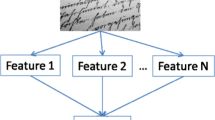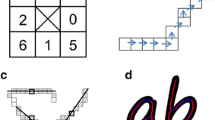Abstract
Writer identification (WI) is a typical pattern recognition problem with the goal of recognizing the writer of a text from images of his or her handwriting. For handwriting-based applications, a new approach is required that can confirm the writer based on a very small amount of available text. However, due to the limited number of characters and the diverse contents of the available samples, it is still challenging to achieve a high recognition rate on large-scale databases. To solve this problem, this paper proposes an efficient method for offline text-independent WI using redundant writing patterns and dual-factor analysis of variance (DF-ANOVA). In this method, a search for writing patterns in a limited number of handwritten texts is first conducted to generate meaningful codebooks. Then, these writing patterns are described by means of the simplified Wigner distribution function (WDF) and improved directional index histogram (DIH) descriptors to extract both structural and texture features, and the two corresponding feature distances are integrated by means of a fuzzy integral rule to make the final decision. The Fisher discriminant ratio (FDR) is used for feature selection, and DF-ANOVA is used to eliminate the influence of factors associated with the labels of samples on the feature distance. The results of evaluations on the IAM (96.92%), Firemaker (96.4%), and Uyghur2016 (100%) databases illustrate that this system shows strong robustness to an increasing number of writers and a decreasing number of words in the sample texts.









Similar content being viewed by others
References
Abdi MN, Khemakhem M (2015) A model-based approach to offline text independent Arabic writer identification and verification. Pattern Recogn 48:1890–1903
Aubin V, Mora M, Santos-Pen̈as M (2018) Off-line writer verification based on simple graphemes. Pattern Recogn 79:414–426
Abualigah LM, Khader AT, Hanandeh ES (2018) A new feature selection method to improve the document clustering using particle swarm optimization algorithm. J Comput Sci 25:456–466
Abualigah LM, Khader AT, Hanandeh ES (2018) Hybrid clustering analysis using improved krill herd algorithm. Appl Intell 48:4047–4071
Abualigah LM, Khader AT, Al-Betar MA, Alomari OA (2017) Text feature selection with a robust weight scheme and dynamic dimension reduction to text document clustering. Expert Syst Appl 84:24–36
Abualigah LM (2019) Feature Selection and Enhanced Krill Herd Algorithm for Text Document Clustering. Studies in Computational Intelligence
Bertolini D, Oliveira L, Justino E, Sabourin R (2013) Texture-based descriptors for writer identification and verification. Expert Syst Appl 40(6):2069–2080
Brink A, Smit J, Bulacu M, Schomaker L (2012) Writer identification using directional ink-trace width measurements. Pattern Recogn 45(1):162–171
Bulacu M, Schomaker L, Vuurpijl L (2003) Writer identification using edge-based directional features. In ICDAR ’03: Proc Int Conf Doc Anal Recogn:937–941
Chahi A, El merabet Y, Ruichek Y, Touahni R (2019) An effective and conceptually simple feature representation for off-line text-independent writer identification. Expert Syst Appl 123:357–376
Chahi A, El merabet Y, Ruichek Y, Touahni R (2020) Local gradient full-scale transform patterns based off-line text-independent writer identification. Appl Soft ComputJ 92:106277. https://doi.org/10.1016/j.asoc.2020.106277
Chahi A, El merabet Y, Ruichek R, Touahni R (2020) Cross multi-scale locally encoded gradient patterns for off-line text-independent writer identification. Eng Appl Artif Intell 89(103459):1–17. https://doi.org/10.1016/j.engappai.2019.103459
Chen S, Wang Y, Lin C, Ding W, Cao Z (2019) Semi-supervised feature learning for improving writer identification. Inf Sci 482:156–170
Chen J, Patel VM, Liu L, Kellokumpu V, Zhao G, Pietikäinen M, Chellappa R (2017) Robust local features for remote face recognition. Image Vis Comput 64:34–46
Christlein V, Gropp M, Fiel S, Maier A (2018) Unsupervised feature learning for writer identification and writer retrieval. In: Proceedings of the international conference on document analysis and recognition, pp 991–997
Christlein V, Bernecker D, Hönig F, Maier A, Angelopoulou E (2017) Writer Identification Using GMM Supervectors and Exemplar-SVMs. Pattern Recogn 63:258–267
DeGroot MH, Schervish MI (2005) Probability and Statistics. Higher Education Press, Beijing, pp 324–332
Ghiasi G, Safabakhsh R (2013) Offline text-independent writer identification using codebook and efficient code extraction methods. Image Vis Comput 31(5):379–391
Hadjadji B, Chibani Y (2018) Two combination stages of clustered One-Class Classifiers for writer identification from text fragments. Pattern Recogn 82:147–162
Hannad Y, Siddiqi I, El Kettani MEY (2016) Writer identification using texture descriptors of handwritten fragments. Expert Syst Appl 47:14–22
He S, Schomaker L (2017) Beyond OCR: multi-faceted understanding of handwritten document characteristics. Pattern Recogn 63:321–333
He S, Wiering M, Schomaker L (2015) Junction detection in handwritten documents and its application to writer identification. Pattern Recogn 48(12):4036–4048
He S, Schomaker L (2017) Writer identification using curvature-free features. Pattern Recogn 63:451–464
He S, Schomaker L (2019) Deep adaptive learning for writer identification based on single handwritten word images. Pattern Recogn 88:64–74
Helli B, Moghaddam ME (2010) A text-independent persian writer identification based on feature relation graph(FRG). Pattern Recogn 43(6):2199–2209
Hough PVC Methods and Means for Recognizing Complex Patterns. U.S. Patent 3069654.1962
Javidi M, Jampour M (2020) A deep learning framework for text-independent writer identification. Eng Appl Artif Intell 95(103912):1–9. https://doi.org/10.1016/j.engappai.2020.103912
Kumar P, Sharma A (2020) Segmentation-free writer identification based on convolutional neural network. Comput Electr Eng 85:106707. https://doi.org/10.1016/j.asoc.2020.106277
Khalifa E, Al-Maadeed S, Tahir MA, Bouridane A, Jamshed A (2015) Off-line writer identification using an ensemble of grapheme codebook features. Pattern Recogn Lett 59:18–25
Khan FA, Khelifi F, Tahir MA, Bouridane A (2019) Dissimilarity Gaussian mixture models for efficient offline handwritten text-independent identification using SIFT and rootSIFT descriptors
Khan FA, Tahir MA, Khelifi F, Bouridane A, Almotaeryi R (2017) Robust off-line text independent writer identification using bagged discrete cosine transform features. Expert Syst Appl 71:404–415
Liu CL, Yin F, Wang DH, Wang QF (2013) Online and offline handwritten chinese character recognition: benchmarking on new data bases. Pattern Recogn 46(1):155–162
Marti UV, Bunke H (2002) The IAM-database: an English sentence database for offline handwriting recognition. Int J Doc Anal Recogn 5(1):39–46
Newell AJ, Griffin LD (2014) Writer identification using oriented basic image features and the delta encoding. Pattern Recogn 47(6):2255–2265
Nguyen HT, Nguyen CT, Ino T, Indurkhya B, Nakagawa M (2019) Text-independent writer identification using convolutional neural network. Pattern Recogn Lett 121:104–112
Otsu N (1979) A threshold selection method from gray-level histograms. IEEE Trans Syst Man Cybern 9(1):62–66
Schomaker L, Bulacu M (2004) Automatic writer identification using connected-component contours and edge-based features of upper case western script. IEEE Trans Pattern Anal Mach Intell 26(6):787–798
Schomaker L, Franke K, Bulacu M (2007) Using codebooks of fragmented connected-component contours in forensic and historic writer identification. Pattern Recogn Lett 28(6):719–727
Siddiqi I, Vincent N (2010) Text independent writer recognition using redundant writing patterns with contour-based orientation and curvature features. Pattern Recogn 43(11):3853–3865
Sreeraj M, Idicula SM (2011) A survey on writer identification schemes. Int J Comput Appl 26(2):23–33
Tan GJ, Sulong G, Rahima MSMR (2017) Writer identification: A comparative study across three world major languages. Forens Sci Int 279:41–52
Wang S, Li D, Song X, Wei Y, Li H (2011) A feature selection method based on improved Fisher’s discriminant ratio for text sentiment classification. Expert Syst Appl 38:8696–8702
Wu X, Tang Y, Bu W (2014) Offline text-independent writer identification based on scale invariant feature transformation. IEEE Trans Inf Forensic Secur 9(3):526–536
Xiao J, Tian H, Zhang Y, Zhou Y, Lei J (2018) Blind video denoising via texture aware noise estimation. Comput Vis Image Understand 169:1–13
Xiao J, Zou W, Chen Y, Wang W, Lei J (2018) Single image rain removal based on depth of field and sparse coding. Pattern Recogn Lett 116:212–217
Zhang D, Han J, Han J, Shao L (2016) Cosaliency detection based on intra saliency prior transfer and deep inter saliency mining. IEEE Trans Neural Netw Learn Syst 27(6):1163–1176
Zhang Y, Xiao J, Peng J, Ding Y, Liu J, Guo Z, Zong X (2018) Kernel Wiener filtering model with low-rank approximation for image denoising. Inf Sci 462:402–416
Zhou P (2012) MATLAB Probability and mathematical statistics. Tsinghua University Press, pp 249–252
Acknowledgements
This work was supported by:(1) The Open Project Program Foundation of the Key Laboratory of Opto-Electronics Information Processing, Chinese Academy of Sciences (Grant No.: OEIP-O-202009). (2) Natural Science Foundation of Xinjiang Uygur Autonomous Region (Grant No. 2020D01A76). (3) University Research Program Natural Science Youth Project of Xinjiang Uyghur Autonomous Region , (Grant No.: XJUDU2019Y032).(4) Subject of Bidding for Key Laboratory of Xinjiang Normal University (Grant No: XJNUSYS092018A02).
Author information
Authors and Affiliations
Corresponding authors
Additional information
Publisher’s note
Springer Nature remains neutral with regard to jurisdictional claims in published maps and institutional affiliations.
Rights and permissions
About this article
Cite this article
Litifu, A., Yan, Y., Xiao, J. et al. Writer identification using redundant writing patterns and dual-factor analysis of variance. Appl Intell 51, 8865–8880 (2021). https://doi.org/10.1007/s10489-021-02307-4
Accepted:
Published:
Issue Date:
DOI: https://doi.org/10.1007/s10489-021-02307-4




